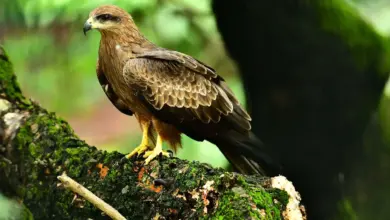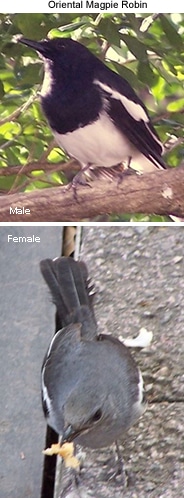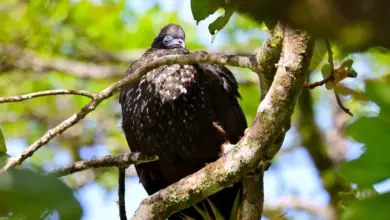Long-tailed Hermits
The Long-tailed Hermits (Phaethornis superciliosus) – also referred to as Eastern Long-tailed Hermit – is a large, South American hummingbird that is found in Venezuela, the Guianas, and north-eastern Brazil.
They inhabit forest undergrowth and are usually found near water and their preferred feeding territories.
Description
The Long-tailed Hermit averages 13.5 cm (5.3 inches) long – including its tail and long, slightly curved bill, which alone is 3.6-4.3 cm (1.4 – 1.7 inches) long. The black lower bill is red-tipped.
The central, white-tipped feathers of the tapered tail are about 6.3 to 6.8 cm (1.7 to 2.7 inches) long.
The average weight is 4-6 g (0.1 – 0.2 oz).
The adult Long-tailed Hermit has a mostly dull brownish-green upper plumage with a buff-tinged rump (lower back). A wide dark band stretches through the eyes, bordered above and below with whitish-buff stripes. The under plumage is a pale greyish-buff color.
Males and females look alike; however, the female is slightly smaller.
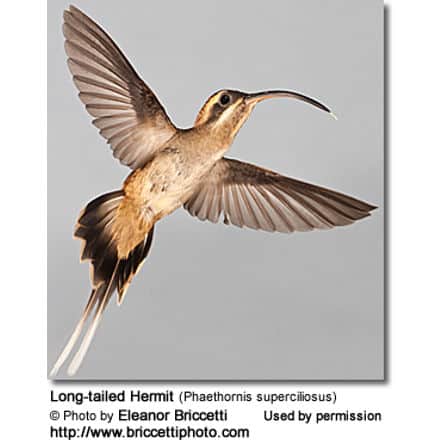
Nesting / Breeding
Long-tailed Hermits have a long breeding season that may start as early as December or January and stretches through August or September – when their feeding flowers are abundant.
Male Long-tailed Hermits sing in communal leks (= gathering of males for competitive mating displays) of up to 25 males to attract females. During this display, the males will wiggle their long tails and sing to the females. The competitive mating display can take half a day.
The female will select the best singer to mate with. After mating, they separate and the female returns to her breeding territory to proceed with the next step, which is preparing for and raising a family.
The female Long-tailed Hermit alone is responsible for building the cone-shaped nest out of plant fibers woven together and green moss on the outside for camouflage in a protected location in a shrub, bush, or tree or she may attach herself to the underside of the broad leaves of the Heliconia plant or banana tree. She usually constructs the nest before mating begins and finishes it off afterward.
She lines the nest with soft plant fibers, animal hair, and feathers down, and strengthens the structure with spider webbing and other sticky material, giving it an elastic quality to allow it to stretch to double its size as the chicks grow and need more room. The nest is typically found on a low, thin horizontal branch.
The average clutch consists of two white eggs, which she incubates alone. The young are born blind, immobile, and without any down.
The female alone protects and feeds the chicks with regurgitated food (mostly partially digested insects since nectar is an insufficient source of protein for the growing chicks). The female pushes the food down the chicks’ throats with her long bill directly into their stomachs.
As is the case with other hummingbird species, the chicks are brooded only the first week or two and are left alone even on cooler nights after about 12 days – probably due to the small nest size. The chicks leave the nest when they are about 7 – 10 days old.
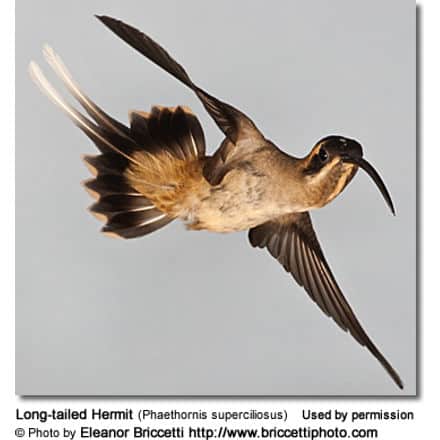
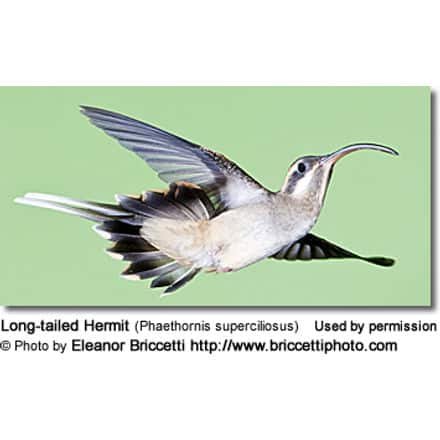
Diet / Feeding
The Long-tailed Hermits primarily feed on nectar taken from a variety of seasonal, brightly colored, scented, large flowers of trees, shrubs, and epiphytes – with their favorite feeding plants being the broad-leafed Heliconias, gingers, and passion flowers,
They favor flowers with the highest sugar content (often red-colored and tubular-shaped) and seek out, and aggressively protect, those areas containing flowers with high-energy nectar. They use their long, extendible, straw-like tongues to retrieve the nectar while hovering with their tails cocked upward as they are licking at the nectar up to 13 times per second. Sometimes they may be seen hanging on the flower while feeding.
Many native and cultivated plants on whose flowers these birds feed heavily rely on them for pollination. The mostly tubular-shaped flowers exclude most bees and butterflies from feeding on them and, subsequently, from pollinating the plants.

They may also visit local hummingbird feeders for some sugar water, or drink out of bird baths or water fountains where they will either hover and sip water as it runs over the edge; or they will perch on the edge and drink – like all the other birds; however, they only remain still for a short moment.
They also take some small spiders and insects – important sources of protein particularly needed during the breeding season to ensure the proper development of their young. Insects are often caught in flight (hawking); snatched off leaves or branches, or taken from spider webs. A nesting female can capture up to 2,000 insects a day.
Males establish feeding territories, where they aggressively chase away other males as well as large insects – such as bumblebees and hawk moths – that want to feed in their territory. They use aerial flights and intimidating displays to defend their territories.
Calls / Vocalizations
The Long-tailed Hermit’s call is described as a series of sharp tusk sounds.

Hummingbird Resources
- Hummingbird Information
- Hummingbird Amazing Facts
- Attracting Hummingbirds to Your Garden
- Hummingbird Species
- Feeding Hummingbirds

